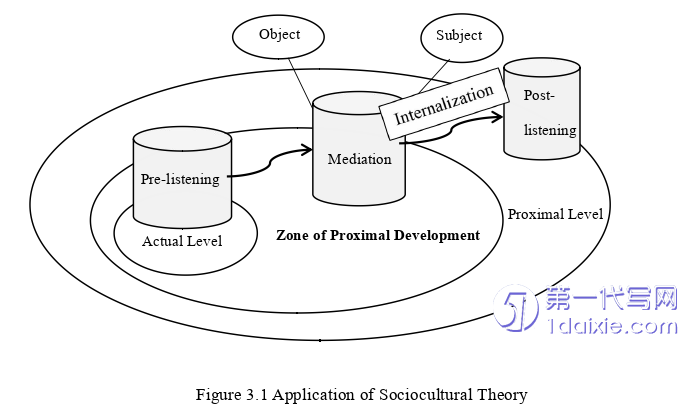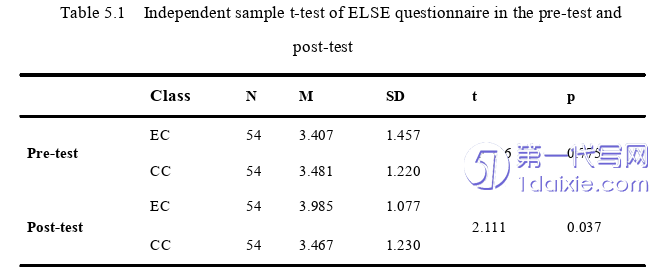本文是一篇英语论文,本研究以广东省佛山市某一初中的两个平行班学生作为研究对象,开展为期12周的动态评价实验教学。其中控制班开展动态评价实验,而对照班采用传统的听力后集中讲评的教学方式。
Chapter One Introduction
1.1 Background of the Study

Listening,speaking,reading,and writing account for 45.5%,16.6%,30.0%,and9.0%of People's Everyday Lives,respectively(Zhang,Wang&Miao,2020).Listening is a crucial life skill.Due to the high frequency of language acquisition indaily life,listening is also essential to second language learning.The EnglishCurriculum Standards for Compulsory Education(Revised in 2022)makes it clear thatlistening,as a comprehension skill,is an essential component of language applicationability and is regarded as a crucial foundation for the development of languageexpression ability among learners.Learners'subjective listening comprehension isstill a complex and difficult-to-visualize process.It is a psychologically complexprocess of lexical discrimination and meaning reconstruction.(Shi,2009).It ischallenging for listeners to"rewind"or pause the input process in real-timecommunication to absorb the received information(Graham,2011).Due to theimmediacy and intricacy of the listening process,it has always been challenging toenhance listening abilities in language learning.The ephemeral processing of oralinput is the essence of the retarded development of listening comprehension capacity,particularly for learners with low self-efficacy(Graham,2011).
Owing to the difficulties of short-term progress and the complexity of thelistening process,teachers used to tend to devote limited teaching time to improvingreading and writing skills,for which it is easier to obtain immediate results andneglect the in-depth study of listening teaching.Currently,teachers continue to utilizethe traditional teaching style of"listen to the tape-students answer the questions onthe listening material-teacher corrects students'wrong answer"in the listening class.However,listening strategies are not taught.
1.2 Purposes of the Research
As a vital aspect of the motivation system,many empirical studies have revealedthat self-efficacy is crucial in enhancing students'listening ability in listeninginstruction.(Mills,Pajares&Herron,2006;Yabukoshi,2021;Xu,Fan&Luo 2021).Admittedly,only some empirical studies on the self-efficacy cultivation mechanism(Wu&Zhang,2010).Even more empirical data is needed on how to develop listeningself-efficacy.Due to the current struggles in middle school listening instruction,it isnecessary to conduct an empirical study on improving middle school students'listening self-efficacy to discuss how to improve their listening comprehension andperformance.
Through experimental research,Jia,Yang&Zhang(2022)discovered thatdynamic assessment could increase college students'self-efficacy with a higheducation background.Dynamic assessment as a teaching approach emergedrelatively late in domestic research,primarily still experiencing the conceptintroduction and model exploration stages.(Chen,2021;He,2013;Huang,2020;Yang,2011).Also,research regarding dynamic assessment is infrequently integratedwith other language abilities,such as listening,speaking,reading,and viewing,toinvestigate the effect of dynamic assessment on comprehensive language ability.Inaddition,little research has examined the effect of dynamic assessment on othercomponents of language acquisition when paired with other variables.
Chapter Two Literature Review
2.1 Self-Efficacy
This part will begin with an explanation of the important definitions,functions,and affecting elements of the root of listening self-efficacy-self-efficacy.In addition,the relationship between listening self-efficacy and listening comprehension andprevious studies on listening self-efficacy improvement will be depicted in detail.
2.1.1 Self-efficacy in language learnin
As the dependent variable under the treatment of this study,listeningself-efficacy is primarily rooted in the concepts of self-efficacy,initially brought byBandura(1977)into the theoretical framework of social cognition.He defined"self-efficacy"as the level of confidence an individual has in his or her capacity toplan and execute a given course of action to accomplish a specific activity or reach aparticular objective.It can have a dramatic and lasting effect on individuals'motivations and behavior patterns.
Bandura(1986)believed that self-efficacy primarily serves four purposes:
(1)It determines the individual's choice of activity tasks.
(2)It affects the individual's perspective and stance toward setbacks andobstacles.
(3)It determines the degree of individual behavioral motivation.
(4)It determines the individual's attitude and emotion toward a particularactivity task.
2.2 Dynamic Assessment
In this section,the comparison of dynamic assessment and static assessment isthen followed by an explanation of two distinct dynamic assessing models.Then theprevious studies of the effects of dynamic assessment are presented.
2.2.1 Dynamic assessment and static assessment
assessment is a technique or instrument for measuring students'comprehensionand proficiency in a particular course.Static assessment,including formativeassessment,and summative assessment is now the most prevalent method ofinstructional assessment in mainstream language education.A pragmatic function ofteaching assessment is to assist students in gaining self-awareness and self-discovery,maintaining and enhancing their enthusiasm and self-confidence in English learningwith direct experience of perceived progress and achievement.The other generallyused function of teaching assessment is to provide teachers with dependable feedbackregarding students'current learning levels and teaching effectiveness.Due to theprominent status of teaching assessment,in addition,under the context of new curriculum reform,teaching,learning,and assessing in the English curriculum areintegrated into a scientific system instead of separate activities any longer;theintegration is bound to mean that the assessment runs throughout the entire teachingand learning process in the English curriculum rather than apart from the process.(The Ministry of Education,2022).To go with the stream of reform and take the mostsignificant advantage of the strength of assessment in the teaching and learningprocess,researchers commit to finding another assessment method to substitute forstatic assessment,which neglects students'cognitive development during the learningprocess;that is why dynamic assessment has been getting attention in the field oflanguage learning.
Chapter Three Theoretical Foundations ....................... 29
3.1 Sociocultural Theory ...................... 29
3.1.1 Main contents of Sociocultural Theory ...................................... 29
3.1.2 Sociocultural Theory as a foundation of dynamic assessment .. 32
Chapter Four Research Method ................................. 38
4.1 Research Questions .................................. 38
4.2 Research Participants ...................................... 39
4.3 Research Instruments .......................................... 40
Chapter Five Results and Discussion ................... 60
5.1 Results ............................... 60
5.1.1 Results of ELSE questionnaires ..................................... 60
5.1.2 Results of ELSE questionnaires of students at different listening self-efficacy levels .............................. 62
Chapter Five Results and Discussion
5.1 Results
This chapter specifies the measured data results before and after the instructionalexperiment to answer the two research questions of this study.Therefore,this sectionwill be divided into three modules.The first one is to compare the changes in theprompts in the pre-test and post-test of EC and CC listening self-efficacy.Then,it willfocus on comparing the changes of EC students with different levels of listeningself-efficacy in the pre-test and post-test.Finally,expounding on the correlationbetween listening self-efficacy and static listening performance is necessary.Inaddition to revealing the data results,this section presents possible reasons for thedifferences in data in each module.
5.1.1 Results of ELSE questionnaires
To examine the effects of DA on listening self-efficacy,a T-test on independentsamples should be performed to determine whether the pre-test level of EC and CC iscomparable and whether the post-test findings of EC are significantly different fromthose of CC.Assume that the ELSE questionnaire's pre-test amounts of EC and CCare consistent.In this situation,as long as the post-test findings of EC and CC differ significantly,it can be concluded that the DA experiment affects the participants'listening self-efficacy.In conjunction with specific descriptive data,it is possible todetermine the effect of the DA experiment on the subjects'listening self-efficacy,suchas positive or negative feedback.Table 5.1 displays the descriptive statistical findingsof listening self-efficacy in the pre-test and post-test in accordance using the previousrationale.Through the ELSE questionnaire pre-test and post-test administered by ECand CC,it is determined that the teaching experiment of DA has a significantfavorable effect on the subjects'listening self-efficacy.

Chapter Six Conclusions
6.1 Major Findings
Via contrastive teaching experiments,this study investigates whether DA plays asignificant role in the English listening self-efficacy of junior middle school studentsand the influence of DA on learners with varying levels of listening self-efficacy.Inorder to determine the feasibility and applicability of DA in junior middle schoolEnglish classes,the correlation between listening self-efficacy and listeningperformance is examined.This study uncovered the following conclusions throughintegrated quantitative and qualitative data collection and analysis.
First,EC learners'listening self-efficacy is enhanced significantly after the DAexperiment.Through the application of DA,data from the ELSEQ post-test showssignificantly positive changes of the listening self-efficacy in EC students than databefore DA and significantly better than that of CC students.Compared to static andtraditional teaching approaches,such as inquiry commenting following listening tests,the results indicate that DA is significantly more effective in cultivating andenhancing learners'listening self-efficacy.
Second,DA has significant positive effects on the listening self-efficacy oflearners at medium and low listening self-efficacy levels.At the same time,there areno significant changes in the high listening self-efficacy group.After DA,the mediumand low listening self-efficacy groups significantly improved according toquantitative data.However,post-test data on students with high listening self-efficacyand the qualitative analysis of semi-structured interviews suggest an alternative result.During the DA,it was discovered that initially,proficient learners considered they hadlosing the concentration from their teachers and some opportunities to challengethemselves with complex listening tasks.Thus,they maintained an unfavorable view of DA.Nevertheless,students with medium and low listening self-efficacy believethat DA can boost their self-confidence and significantly improve in listeningcomprehension.Hence,they have a favorable attitude toward it.
reference(omitted)
